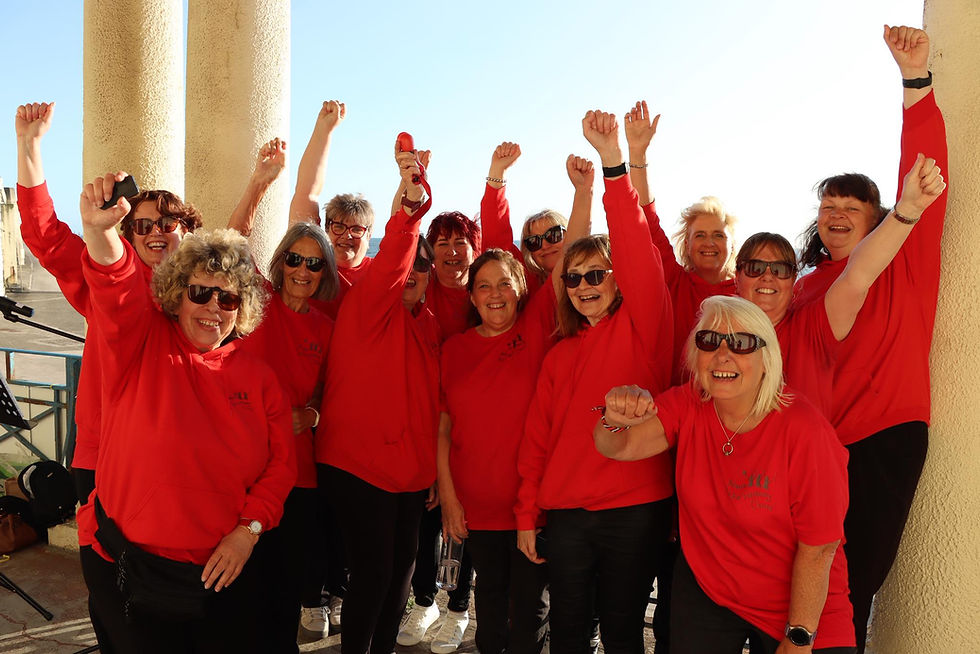Before You Join: Why Choir Structure Matters More Than You Think
- Tanya Lawrence

- Jul 22
- 4 min read
Updated: Aug 18
If you’ve ever thought about joining a choir - or if you’re already part of one - it’s
worth pausing to ask: Who runs this choir, and how?
It might not be the first question that comes to mind when you’re imagining
harmonies and applause, but understanding how a choir is structured can make a
real difference to your experience. Whether you thrive on collaboration, prefer
clear leadership, or love being part of something big and exciting, the internal
setup of a choir can shape everything from how decisions are made to how
connected you feel.
Let’s explore the most common choir structures in the UK and the pros and cons
of each.
1. Community Choir (Committee-Led)
What it is:
A community choir is usually set up and run by its members, with a committee
elected to manage things like finances, rehearsal schedules, venues, and events.
These choirs often have founding members and hold annual general meetings
where leadership roles may change.
Pros:
• Members can get involved in decision-making.
• There is often a strong sense of shared ownership and camaraderie.
• It can reflect the character and values of the local community.
Cons:
• Decision-making can be slow or conflict-prone.
• Musical and creative direction may become diluted if too many opinions are
weighed equally.
• Committee turnover can cause inconsistency.
• Levels of experience and knowledge of committee members may fluctuate.
Best for you if:
You enjoy being part of grass roots projects, want your voice heard in
organisational matters, and don’t mind a little admin now and then.
2. Franchise Choir
What it is:
Franchise choirs are part of a larger network of choirs operating under the same
brand. Each location has its own Musical Director, but they all follow a centralised
syllabus and structure set by the franchise owner.
Pros:
• High-quality branding and resources.
• Exciting opportunities for large-scale performances (regional or national).
• Clear, consistent structure and song choices across locations.
Cons:
• Little or no influence on repertoire or choir policies.
• Less personal connection to the leadership.
• Decisions made top-down, often without member consultation.
Best for you if:
You love singing familiar music with a wide community, enjoy structured systems,
and don’t mind leaving decisions to someone else.
3. Director-Led Choir (Boutique Model)
What it is:
These choirs are often founded and run as part of a small businesses model by a
sole trader or partnership of two or more directors. Our own Women Rockin’
Harmony Choirs® is a perfect example. There may be multiple teams working
under the same ethos and material, with occasional opportunities to unite for large
events or to fulfil a guest spot at a local event.
Pros:
• Direct, regular access to the leadership.
• More personalised guidance and a stronger identity.
• The chance to be part of something intimate but professionally run.
Cons:
• No voting rights or formal committee - decisions rest solely with the directors.
• If the directors were to leave, the choir may not continue without them.
Best for you if:
You want a strong, inspiring leader, appreciate a well-organised system, and
prefer to focus on the singing rather than the admin.
4. Institutional Choir (e.g., Workplace, Faith-Based, or Educational)
What it is:
These choirs are linked to an organisation such as a school, university, workplace,
or religious institution. The structure tends to reflect that of the host organisation.
Pros:
• Convenient and often free to join if you’re part of the host organisation.
• Rehearsals often fit within the existing schedule or culture.
• Built-in audience for performances.
Cons:
• Repertoire and goals may be driven by institutional priorities rather than
musical ones.
• Less flexibility in performance opportunities and rehearsal planning.
Best for you if:
You want to sing in a convenient, familiar setting and are happy for music to reflect
the values or purpose of the parent organisation.
5. Project-Based or Ad-Hoc Choir
What it is:
These choirs are formed for a single event or short-term project—often with a
defined start and end. This might be a charity concert, a studio recording, or a
one-off festival appearance.
Pros:
• Low commitment and high intensity.
• Great for specific goals (e.g., singing in a famous venue or collaborating with
professionals).
• Refreshing and energising experience.
Cons:
• No long-term community.
• Little chance to develop relationships or vocal blend over time.
Best for you if:
You’re a musical adventurer looking for a short-term challenge or unique
performance.
So - What’s the Takeaway?
There’s no one-size-fits-all answer. The best choir for you depends on your
personality, your goals, and your preferences. Do you want a say in how things
are run? Do you prefer a clear chain of command? Are you looking for deep
community bonds, or thrilling one-off events?
By taking a little time to explore websites and find out how the choir you have in
mind is run, you’ll be far more likely to find the choir that truly feels like home.

If you'd like to find out if Women Rockin' Harmony Choirs® fit the bill for you, you can find out more about our annual recruitment opportunities here.




Comments